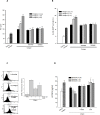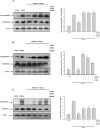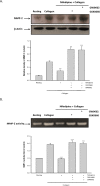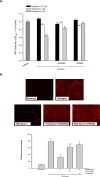Mechanisms of Nifedipine-Downregulated CD40L/sCD40L Signaling in Collagen Stimulated Human Platelets
- PMID: 25970603
- PMCID: PMC4430314
- DOI: 10.1371/journal.pone.0127054
Mechanisms of Nifedipine-Downregulated CD40L/sCD40L Signaling in Collagen Stimulated Human Platelets
Abstract
The platelet-derived soluble CD40L (sCD40L) release plays a critical role in the development of atherosclerosis. Nifedipine, a dihydropyridine-based L-type calcium channel blocker (CCB), has been reported to have an anti-atherosclerotic effect beyond its blood pressure-lowering effect, but the molecular mechanisms remain unclear. The present study was designed to investigate whether nifedipine affects sCD40L release from collagen-stimulated human platelets and to determine the potential role of peroxisome proliferator-activated receptor-β/-γ (PPAR-β/-γ). We found that treatment with nifedipine significantly inhibited the platelet surface CD40L expression and sCD40L release in response to collagen, while the inhibition was markedly reversed by blocking PPAR-β/-γ activity with specific antagonist such as GSK0660 and GW9662. Meanwhile, nifedipine also enhanced nitric oxide (NO) and cyclic GMP formation in a PPAR-β/-γ-dependent manner. When the NO/cyclic GMP pathway was suppressed, nifedipine-mediated inhibition of sCD40L release was abolished significantly. Collagen-induced phosphorylation of p38MAPK, ERK1/2 and HSP27, matrix metalloproteinase-2 (MMP-2) expression/activity and reactive oxygen species (ROS) formation were significantly inhibited by nifedipine, whereas these alterations were all attenuated by co-treatment with PPAR-β/-γ antagonists. Collectively, these results demonstrate that PPAR-β/-γ-dependent pathways contribute to nifedipine-mediated downregulation of CD40L/sCD40L signaling in activated platelets through regulation of NO/ p38MAPK/ERK1/2/HSP27/MMP-2 signalings and provide a novel mechanism regarding the anti-atherosclerotic effect of nifedipine.
Conflict of interest statement
Figures






Similar articles
-
Mechanisms of antiplatelet activity of nifedipine: role of peroxisome proliferator-activated receptor-β-γ-dependent processes.J Hypertens. 2014 Jan;32(1):181-92. doi: 10.1097/HJH.0000000000000007. J Hypertens. 2014. PMID: 24126710
-
The antiplatelet activity of magnolol is mediated by PPAR-β/γ.Biochem Pharmacol. 2012 Sep 15;84(6):793-803. doi: 10.1016/j.bcp.2012.06.022. Epub 2012 Jun 29. Biochem Pharmacol. 2012. PMID: 22750553
-
Antiplatelet activity of nifedipine is mediated by inhibition of NF-κB activation caused by enhancement of PPAR-β/-γ activity.Br J Pharmacol. 2014 Mar;171(6):1490-1500. doi: 10.1111/bph.12523. Br J Pharmacol. 2014. PMID: 24730061 Free PMC article.
-
The signaling role of CD40 ligand in platelet biology and in platelet component transfusion.Int J Mol Sci. 2014 Dec 3;15(12):22342-64. doi: 10.3390/ijms151222342. Int J Mol Sci. 2014. PMID: 25479079 Free PMC article. Review.
-
The CD40-CD40L system in cardiovascular disease.Ann Med. 2011 Aug;43(5):331-40. doi: 10.3109/07853890.2010.546362. Epub 2011 Jan 18. Ann Med. 2011. PMID: 21244217 Review.
Cited by
-
Role of NF-κB in Platelet Function.Int J Mol Sci. 2019 Aug 27;20(17):4185. doi: 10.3390/ijms20174185. Int J Mol Sci. 2019. PMID: 31461836 Free PMC article. Review.
-
Consumption coagulopathy in acute aortic dissection: principles of management.J Cardiothorac Surg. 2017 Jun 12;12(1):50. doi: 10.1186/s13019-017-0613-5. J Cardiothorac Surg. 2017. PMID: 28606160 Free PMC article.
-
The Role of the Proteasome in Platelet Function.Int J Mol Sci. 2021 Apr 13;22(8):3999. doi: 10.3390/ijms22083999. Int J Mol Sci. 2021. PMID: 33924425 Free PMC article. Review.
-
The relationship between soluble CD40 ligand level and atherosclerosis in white-coat hypertension.J Hum Hypertens. 2017 Dec;32(1):40-45. doi: 10.1038/s41371-017-0016-z. Epub 2017 Nov 21. J Hum Hypertens. 2017. PMID: 29162926
-
Hemorrhage in pheochromocytoma surgery: evaluation of preoperative risk factors.Endocrine. 2022 May;76(2):426-433. doi: 10.1007/s12020-021-02964-y. Epub 2022 Apr 15. Endocrine. 2022. PMID: 35426588 Free PMC article.
References
Publication types
MeSH terms
Substances
LinkOut - more resources
Full Text Sources
Other Literature Sources
Research Materials
Miscellaneous

